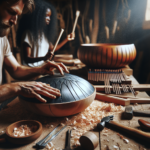The world of music is vast and ever-expanding, much like the cosmos. It’s an intricate tapestry woven from diverse traditions, cultures, and histories. While Western music is often associated with the 12-tone equal temperament scale, there’s a vast spectrum of musical exploration that lies beyond these conventional boundaries. This is where microtonal music, an avant-garde realm of sound, presents itself as an intriguing frontier for musicians, especially for handpan enthusiasts who seek to infuse their performances with a distinct sense of innovation.
Microtonal tuning can be likened to opening a portal into an unexplored dimension of music. For handpan players, this opportunity to delve into microtonal music offers a refreshing escape from conventional Western scales. While the handpan is adored for its accessible pentatonic scales and entrancing tones, microtonal tuning grants the artist the freedom to explore new textures, unique tunings, and culturally rich scales that can enhance the expressive capabilities of this modern instrument.
The Basics of Microtonal Music
To understand microtonal music, it helps to first consider its definition. The term “microtonal” refers to intervals that are smaller than the customary semitone in the Western 12-tone equal temperament scale. Thus, microtones are the bits of pitch that exist between the conventional pitches found in standard Western music scales. They are found in many non-Western musical systems, such as the maqaam in Arabic music or shrutis in Indian classical music.
Microtonal music isn’t just about splitting a semitone into smaller parts. It includes any musical scale or tuning system that incorporates unconventional pitches. This has opened doors for new compositions and performances that diverge from the comforting predictability of the 12-tone system, allowing musicians to explore uncharted sonic landscapes.
The Handpan and Microtonal Possibilities
The handpan, an instrument blending percussive and melodic qualities, has enjoyed a surge in popularity due to its immersive soundscapes and the meditative state it can evoke in both players and listeners. Traditionally, handpans are tuned using relatively accessible scales, such as the D minor or C major pentatonic.
However, the journey into microtonal possibilities is being embraced by a growing community of handpan tuners and players. Incorporating microtones can transform the emotional and aesthetic quality of a handpan, offering audiences an auditory experience that is both novel and enchanting. Each microtonal handpan is unique, reflecting the individuality of its creator’s artistic vision and the specific musical elements they wish to explore.
For instance, one might experiment with a handpan tuned in quarter-tone intervals or employ scales from cultures with rich microtonal traditions. These adjustments can provide a refreshing experience, moving listeners to landscapes and emotions that traditional tunings might not fully evoke.
Creating Microtonal Handpans
Crafting a microtonal handpan involves a meticulous process of modifying the steel’s dimples and radius to produce the desired pitches. Unlike mass-produced instruments, these handpans often require custom crafting by skilled tuners who are proficient in microtonal theory and practice.
Many handpan tuners collaborate closely with musicians to carve out sheets of steel into fine-tuned instruments that embody specific artistic goals. This collaborative effort often involves experimenting with different alloys, shapes, and heat treatments to achieve the perfect balance of resonance and pitch accuracy.
The Artistic Appeal
The artistic ramifications of microtonal tuning on the handpan are substantial. Musicians are able to build fluid and evolving compositions that defy traditional harmonic structures, producing sounds that are ethereal, dreamlike, and intriguing. Listeners become travelers on a musical journey into the subconscious, where scales weave a tapestry of unprecedented stories and emotions.
Microtonal handpans encourage musicians to incorporate global influences into their compositions. Scales from various musical traditions offer a multitude of moods and atmospheres for creative exploration. Through these tunings, musicians can connect with global music traditions and audiences on a much deeper level, embracing diversity through sound.
Moreover, microtonal music invites musicians to embrace unconventional melodies and harmonies, expanding their technical proficiency and fostering further musical innovation. This creates a fertile ground for experimentation, redefining the scope of what’s possible in handpan music and contributing to the dynamic evolution of the instrument.
The Challenges of Microtonal Handpans
Despite the enchanting auditory experiences afforded by microtonal handpans, these instruments come with their own set of challenges. The uncharted nature of this exploration demands that musicians cultivate a comprehensive understanding of microtones and their applications.
One of the primary challenges is in the tuning process itself. It involves a high level of precision to ensure that each microtone conveys its intended musical message. Achieving this requires a deep comprehension of both the theory and practice underpinning microtonal music.
Additionally, microtonal music may initially be off-putting to audiences accustomed to traditional Western harmonies. Musicians must be patient as they and their listeners acclimatize to new tonal languages. This necessitates pedagogical efforts and artistic advocacy to bridge cultural and auditory gaps.
The Future of Handpan Music
The evolution of handpan music through microtonal tuning offers a thrilling view of its future. The unconventional sounds and expressive range facilitated by microtones push the handpan toward becoming not just an instrument of meditative and healing purposes, but also a platform for avant-garde explorations and intercultural communication.
As more musicians and tuners experiment with microtonal possibilities, the handpan community may see a more globalized exchange of musical ideas, scales, and compositions. The handpan can transcend its initial design and function, transforming into a bridge between musical worlds that previously seemed discrete.
Conclusion
In conclusion, the exploration of microtonal tuning in handpans represents a compelling and transformative journey beyond Western scales. It encapsulates the spirit of musical exploration and encourages musicians to extend their creative boundaries. While the path may be challenging, the rewards are plentiful—unveiling new soundscapes, deepening musical understanding, and unifying people across diverse cultural landscapes through the universal language of music.
FAQs
1. What are microtones?
Microtones are musical intervals smaller than a semi-tone in the Western tonal system. They exist between the standard pitches of Western scales and are commonly used in non-Western musical traditions.
2. Are microtonal handpans widely available?
Microtonal handpans are not as widely available as traditionally tuned handpans. They are often crafted on demand, with custom tunings designed by skilled tuners who specialize in microtonal music.
3. Do microtonal handpans require special playing techniques?
While the basic playing techniques remain the same, players may need to adapt to the unique tunings and musical scales of microtonal handpans. It can require an openness to exploring unconventional melodies and harmonies.
4. Can I retune a standard handpan to be microtonal?
Retuning a standard handpan to microtonal scales is challenging and not recommended, as it involves significant modifications that might damage the instrument. It’s often better to commission a bespoke microtonal handpan.
5. Is microtonal music difficult to appreciate?
Initially, microtonal music might sound unfamiliar to those used to Western tonality. However, with exposure, listeners often discover its rich emotional and artistic potential, appreciating the depth and diversity it brings to musical expression.





